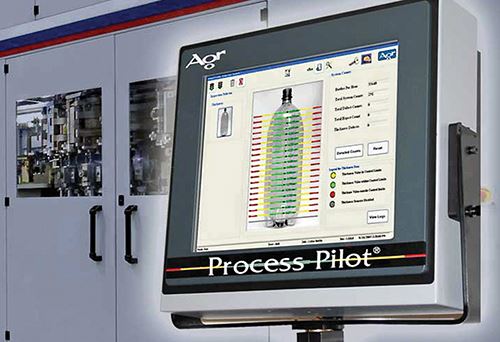BLOW MOLDING: Monitor & Control PET Bottle Crystallinity & Barrier Properties
New QC functions predict shelf-life performance and help optimize physical properties based on crystallinity/orientation.
Two dramatic new additions to online monitoring and control of PET bottle quality were announced at NPE2015 by Agr International, Inc., Butler, Pa. First, Agr has added to its Pilot Profiler in-the-blow-molder thickness-management system for stretch-blown PET bottles. The new function predicts shelf-life performance of the bottle—CO2 and moisture barrier—based on the wall-thickness profile. The math behind the predictive feature is based on the M-Rule container performance model developed by Container Science, Inc., Atlanta. This capability for continuous, nondestructive monitoring of bottle performance can be upgraded to full closed-loop control by adding Agr’s Process Pilot automated blow molding control system to the Pilot Profiler. Process Pilot automatically adjusts machine settings to manage container material distribution to within 0.01 mm.
Another new capability is still in beta testing and is expected to become available as part of Process Pilot in the fourth quarter. Called CrystalView, it addresses crystallinity management as the new frontier in optimizing bottle quality at ever-lighter weights. According to Agr, degree of crystallinity and orientation (two associated properties) are closely correlated with the stretching temperature of the PET preform. For CSD bottles made with the cold-mold process, a cooler preform results in greater orientation during stretching and better bottle performance. On the other hand, stretching a preform that’s too cool results in crazing on the inner surface that correlates with reduced time to stress cracking, an undesirable consequence. Agr’s solution is to monitor pearlescence in the bottle—a sign of crazing—with an electronic camera and adjust the preform temperature to the lowest level above the point of crazing so as to combine highest orientation with longest time to stress cracking.
For heat-set PET bottles made by the hot-mold process, the goal is to maintain dimensional and volumetric stability during hot filling. Higher preform temperatures produce higher crystallinity, but too hot a preform results in crystallinity-induced haze—another undesirable consequence. Agr’s Process Pilot will adjust the preform temperature to the highest level below the hazing point to ensure maximum crystallinity.
Related Content
-
How Inline Vision Inspection Can Minimize Scrap in Molding
Once viewed by injection and blow molders as a necessary evil, machine vision technology today can continuously monitor and improve production while reducing costs.
-
Foam-Core Multilayer Blow Molding: How It’s Done
Learn here how to take advantage of new lightweighting and recycle utilization opportunities in consumer packaging, thanks to a collaboration of leaders in microcellular foaming and multilayer head design.
-
Blow Molder with a Mission: CKS Packaging Shares Gains Of Its Phenomenal Growth
From three machines in 1986 to 27 plants nationwide today, this family-owned processor has prospered through unwavering customer service, committed employees and dedicated service to its community.














